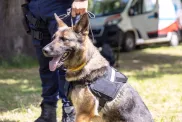This annual conference of the Association of Pet Dog Trainers attracts the most respected experts from around the continent, and 2008 was no exception. Some sessions took on an academic flavor, like “Conditioned Reinforcement” while some offered practical advice, such as “Keeping Clients Coming Back.” And some were just plain fascinating, like the day-long symposium on dog play behaviors. But most compelling to me as a new attendee? I was hearing for the first time some of the facts and figures most dog trainers already know – and most dog owners need to know…
- The three things your dog needs from you as his benevolent leader: predictability, dependability, and trustworthiness.
- When correcting your dog, be instructive. In other words, don’t simply reprimand him for misbehavior; let him know what he should be doing instead. For example, he’s got his little nose in the trashcan, ready to pull out a used tissue with his teeth. Your move: A stern “Unh unh!” followed by, “Fido, sit!” And then, of course: “Good dog!”
- A sign two dogs are playing well together? Lots of pauses during wrestling bouts and chase sessions. In essence, these pauses break the momentum, preventing dogs from over-arousal, which can cause them to take play to a level closer to fighting. And they provide a chance for one or both dogs to sneak in a play bow, as if to say, “Just to confirm, this next move should still be interpreted as play…”
- Addressing your dog only when she’s doing something wrong isn’t just a drag for both of you, it’s ineffective. Instead, practice constant communication with your dog. Praise her for walking nicely on leash, ignoring the cheese wedge on the coffee table, and sitting quietly when the mailman arrives, That way, she knows what you do want from her as well as what you don’t want.
- Where is your dog most likely to get hit by a car? On the street right in front of your house. Be smart about his off-leash freedom. ‘Nough said.
- Though dogs descended from wolves, the two species evolved in several very different ways to become the animals we know today. Therefore, it can be inappropriate (if not downright dangerous) to approach dog training from a wolf-pack perspective–much as it would be ill-founded to base child-rearing techniques on chimpanzee behavior.
- One example: Wolves’ survival depends on a rigid pack hierarchy with each member conscious of and stanch in her rank. Why? Because wolves are hunters, and living as a pack is the most effective way to successfully hunt for food. Dogs, on the other hand, are primarily scavengers. Though they often live in loosely defined families or groups, this has more to do with the fact that they are social animals than it does with an instinctual drive to find food.
- Another example? Wolves use rank to establish breeding rights. In any given pack, only the “alpha pair” breeds. As for dogs, let’s just be thankful there are spay/neuter laws (because as we know, it’s a free-for-all).
- A sobering note to anyone who thinks dog training isn’t worth their time. The average cost to rehome a dog: Ten thousand dollars.
– by Leslie Smith









